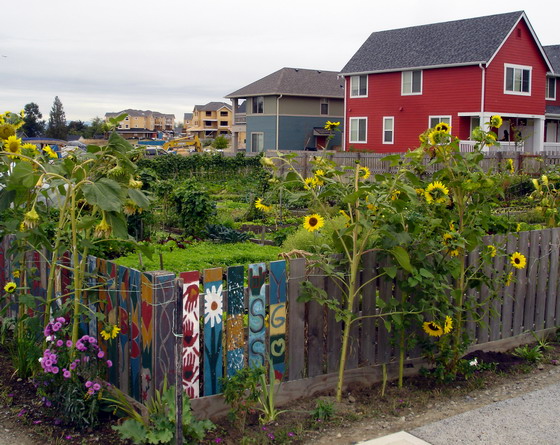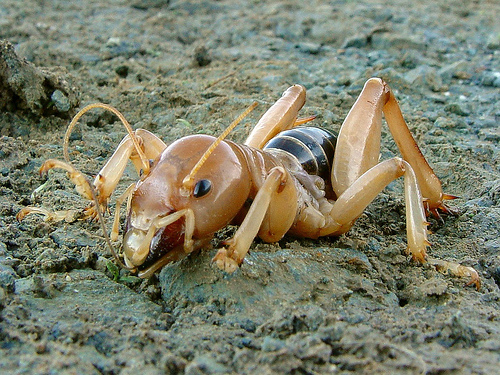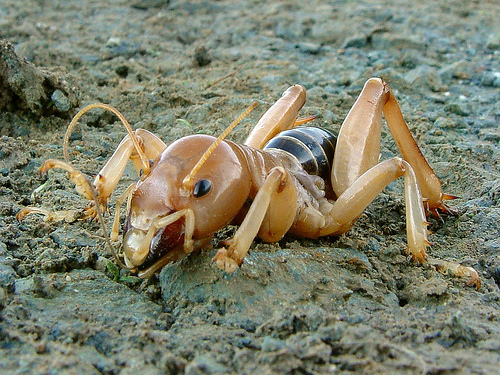 The helpful Jerusalem cricket.Photo: Franco FoliniCross-posted from Cool Green Science.
The helpful Jerusalem cricket.Photo: Franco FoliniCross-posted from Cool Green Science.
There are 1 billion bacteria in a single gram of soil. (Give or take a few million.)
But how can you get that army — and its insect friends, like the two-inch Jerusalem cricket pictured to the right — to help you grow bigger veggies and prettier flowers?
There’s nobody better to ask than Nature Conservancy soil ecologist Sophie Parker, who recently turned Grist on to the fascinating (and sometimes scary) world of soil organisms. I asked Sophie to give us some tips to make our gardens grow even better — through the power of microbes …
Q. How does this work? Why are microbes so important to good gardens?
A. Bacteria, fungi, and other tiny soil microbes have a variety of ways of making a living, and many of their activities enrich the soil.
First off, they are the Earth’s natural recyclers — decomposing complex substances into smaller compounds that can be used by plants. They do this by producing enzymes — special chemical juices that break things down. Some of these enzymes are like guided missiles with a very specific target. Others are more general and work like a wrecking ball to quickly dismantle large particles. Decomposition in soils is a highly sophisticated, active process, and bacteria and fungi control how it happens.
Another important thing that some bacteria do is pull nitrogen out of the air and convert it into a form that plants can use. This is known as “nitrogen fixation.” Because nitrogen is an essential nutrient that plants need for growth, bacterially driven nitrogen fixation can play an important role in determining how productive soil will be.
Q. So, it’s time to grow vegetables and flowers. What kinds of organisms do we want in our gardens to make sure everything grows huge and beautiful?
A. A garden is an excellent place to see a wide array of organisms at work. Each scoop of earth you turn over with your garden trowel is literally crawling with critters! The majority of these are too small to see without a microscope, but some of the larger soil dwellers are very familiar to gardeners. Earthworms, mites, springtails, and spiders are all important members of the soil food web. They aerate the soil, decompose dead material, and serve as natural biocontrol. Seeing these creatures in your yard is a sign of a healthy ecosystem and good quality soil, which is the foundation of a productive garden.
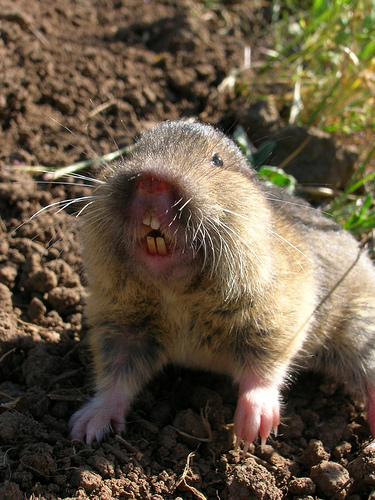 Pocket gopher — not so helpful.Photo: Ken-ichi UedaQ. And which soil critters don’t we want?
Pocket gopher — not so helpful.Photo: Ken-ichi UedaQ. And which soil critters don’t we want?
A. Well, gardeners wage all kinds of battles with pests large and small. It stands to reason that the juicy, plump, and luscious fruits and veggies that grow in backyard gardens are attractive not only to people, but to a variety of other animals as well.
One soil dweller that gardeners often complain about in my community is actually not a microorganism: it’s the pocket gopher. I’ve seen a single gopher send calm, gentle gardeners into fits of rodenticidal rage. But beyond gophers, many of the flying and crawling insects that eat our growing plants spend one or more of their life stages (egg, larvae, pupa, or adult) in the soil. Cutworms are a good example of this: these are the caterpillars of moths that hide in the soil by day and chew through the stems of plants at night. However, trying to attack soil-dwelling organisms to control the pests in your garden is much like searching for a very tiny needle in a huge haystack.
Q. We’re organic gardeners, it goes without saying. So what can we do organically to promote lots of good ones and make the bad ones go away?
A. There are many steps a gardener can take to promote a healthy garden without using toxic pesticides. Local botanical gardens and arboretums can typically provide a wealth of information on this topic, but the first step is to start viewing your garden holistically, as the fully functioning, biodiverse ecosystem that it is. All organisms are on the hunt for food and space, and you can use this knowledge to your advantage to control pests and weeds:
- By varying up the foods and flowers you grow, you reduce the chance that your entire garden will fall victim to being eaten, as many pest organisms are specialist herbivores.
- If an insect is eating your plants, try to figure out what species of insect it is and what might eat it or dissuade it. Some of the best controllers of insects are other insects (i.e. think of how effective ladybugs are at controlling aphids), so using a broad-spectrum, chemically-based insecticide can actually make pest problems worse. Mechanical removal of some species is effective; just pick them off plants (or, if possible, get some chickens to do it for you). Removing small infestations before they become big problems is an effective tactic.
- Altering the soil surface by adding mulch (to prevent weed growth) or egg shells (to deter slugs) can really influence which species enter your garden in the first place. Some natural pest control tactics can also be a lot of fun. Invite some friends over one evening to bait slug traps (pour a little beer into shallow containers at ground level), and your vegetable garden could become an impromptu Biergarten.
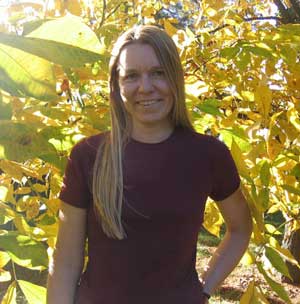 Scientist Sophie Parker delivers the real dirt.Q. I’m in. What about fertilizer — does that help or hurt the beneficial microorganisms?
Scientist Sophie Parker delivers the real dirt.Q. I’m in. What about fertilizer — does that help or hurt the beneficial microorganisms?
A. Synthetic chemical fertilizers can promote some microorganisms while inhibiting others, but the specifics of this relationship will vary from garden to garden, depending on a variety of factors such as the starting condition of the soil. The composition of the soil microbial community will change if fertilizers are applied; some bacteria will benefit and multiply, and others will lose out. This can cause a cascade through the soil food chain, favoring certain amoeba that eat the newly-favored bacteria, the soil mites that eat the amoebae, and the larger insects that eat the mites. Right now, researchers are actively studying these complex soil food webs to understand how the addition of nutrients to soils influences the soil community.
Another thing about synthetic chemical fertilizers: They can require a good deal of fossil fuel to produce. Gardeners interested in minimizing their carbon footprint should begin a compost pile and harness the power of bacteria, fungi, and other microorganisms to decompose their way towards independence from store-bought fertilizers. Composting not only transforms kitchen scraps and yard waste into valuable plant food, it also diverts waste from landfills. And the rich, earthy smell of a healthy compost pile is its own reward.
Q. Mmmmm … good. So what are some of the coolest of these soil critters in gardens? Can we see them?
A. One of my personal backyard favorites is the Jerusalem cricket (Stenopelmatus sp.), which is also known as the potato bug or niña de la tierra (child of the earth). These insects are up to two inches long, tan-colored, bulbous-headed, cricket look-alikes with a striped brown abdomen. (See photo above.) They feed primarily on decomposing material in the soil, but when they come to the surface their odd appearance can startle the uninitiated. Jerusalem crickets often venture out at night, where they become a favorite food of Pallid Bats (Antrozous pallidus).
The more time you spend outside in your garden, the more chances you will have to see the amazing diversity of soil-dwelling creatures it contains. Happy gardening!
